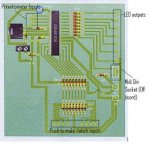Alex Leech
Member
Hi all !!
Just a couple of quick question's before i continue on my project of building a musical control surface for my computer using a pic.
Firstly Is it possible to use a picaxe 28X or 28x1 for midi ?
If not please can somone please post a list of avaliable chips to use.
Secondly Is there a certain output pin on either of these devices that must be used to connect to the midi socket?
Thanks !
Alex
Just a couple of quick question's before i continue on my project of building a musical control surface for my computer using a pic.
Firstly Is it possible to use a picaxe 28X or 28x1 for midi ?
If not please can somone please post a list of avaliable chips to use.
Secondly Is there a certain output pin on either of these devices that must be used to connect to the midi socket?
Thanks !
Alex

